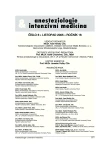Predictive factors of failure of non-invasive positive pressure ventilation in patients with acute respiratory failure due to exacerbation of chronic obstructive airway disease
Prediktivní faktory selhání neinvazivní ventilace pozitivním tlakem (NPPV) u pacientů s akutním respiračním selháním (ARF) při exacerbaci CHOPN
Cíl práce:
Zjistit, které faktory ovlivňují selhání NPPV u pacientů hospitalizovaných na pneumologické JIP pro ARF při exacerbaci CHOPN.
Typ studie:
Retrospektivní studie.
Název a sídlo pracoviště:
Klinika nemocí plicních a tuberkulózy, Fakultní nemocnice Brno.
Soubor a metody:
Retrospektivní studie nemocných hospitalizovaných na pneumologické JIP. Jednalo se o pacienty, kteří měli akutní respirační insuficienci při akutní exacerbaci CHOPN a byli neinvazivně ventilováni pozitivním přetlakem pomocí obličejové masky. Hodnotili jsme efekt NPPV při přijetí a propuštění z JIP. Dále byli nemocní rozděleni do dvou skupin: úspěšně ventilovaných (S) a těch, u kterých selhala NPPV (F). V těchto skupinách jsme hodnotili tyto parametry: vstupní respirační parametry ( pHa, PaO2, PaCO2), DF (dechová frekvence), TF (tepová frekvence), věk, komorbidita, APACHE III skóre (1), BMI (body mass index), výška tlakové podpory (Pinsp), PEEP a respirační parametry za 4 hodiny ventilace.
Výsledky:
Celkem bylo do studie zařazeno 41 pacientů. Ke zlepšení respiračních parametrů došlo u 35 pacientů (86,1 %). Šest pacientů (13,9 %) bylo nutné intubovat a řízeně ventilovat. Zemřeli 4 pacienti (9,8 %) ze skupiny F. Skupina F pacientů, u kterých došlo k selhání NPPV, se významně statisticky nelišila ve věku,vstupních hodnotách pHa, PaO2, PaCO2, DF a zlepšení DF po 4 hodinách ventilace. Skupina F měla vyšší APACHE III, více přidružených onemocnění (p = 0,002) a vyšší vstupní tepovou frekvenci (p = 0,002). Nedošlo u nich ani k signifikantnímu a zlepšení TF a pH po 4 hodinách ventilace.
Závěr:
Závažná polymorbidita, vysoká hodnota APACHE III, vstupní tepové frekvence a absence ústupu tachykardie a zlepšení pHa po 4 hodinách ventilace dobře predikovaly selhání NPPV.
Klíčová slova:
neinvazivní ventilační podpora – chronická obstrukční plicní nemoc – akutní respirační insuficience
Authors:
P. Matuška; O. Pilařová; Z. Merta; J. Skřičková
Authors‘ workplace:
Klinika nemocí plicních a TBC FN Brno
Published in:
Anest. intenziv. Med., 16, 2005, č. 6, s. 291-295
Category:
Intensive Care Medicine - Original Paper
Overview
Objective:
Identification of predictive factors of failure of non-invasive positive pressure ventilation (NPPV) in patients admitted to the respiratory ICU with acute respiratory failure (ARF) due to exacerbation of chronic obstructive airway disease (COPD).
Design:
Retrospective analysis.
Setting:
Department of Respiratory Diseases and Tuberculosis of University Hospital.
Methods:
We performed a retrospective analysis of patients admitted to the respiratory ICU with ARF due to acute exacerbation of COPD treated by non-invasive ventilation using a facemask. We evaluated the effect of NPPV during the admission and discharge from the ICU. We divided the patients in two groups: successfully treated (S) vs. patients who needed tracheal intubation, which was considered as treatment failure (F). We studied the following parameters: arterial blood gas on admission (ABG: pHa, PaO2, PaCO2), respiratory rate (RR), heart rate (HR), age, comorbidity, APACHE III score, BMI, level of ventilatory support (Pinsp) and ABG following 4-hour ventilation.
Results:
41 patients were included. Improvement of ABG on NPPV was observed in 35 patients (86.1 %). Endotracheal intubation and mechanical ventilation were necessary in 6 patients (13.9 %). Four patients in group F died (9.8 %). There was no significant difference between groups S and F in age, initial ABG, RR and its improvement after 4 hours of NPPV. Group F patients had a higher APACHE III score, more concomitant diseases (p=0.002) and higher heart rate on admission (P = 0.002). There was no significant improvement in HR and pHa in group F after 4 hours of NPPV.
Conclusion:
The predictive factors of failure of NPPV were: polymorbidity, high APACHE III score, high HR on admission, and high HR and low pH after 4 hours of ventilation.
Key words:
non-invasive ventilatory support – chronic obstructive airway disease – acute respiratory failure
Labels
Anaesthesiology, Resuscitation and Inten Intensive Care MedicineArticle was published in
Anaesthesiology and Intensive Care Medicine

2005 Issue 6
Most read in this issue
- The role of linezolide in the treatment of resistant gram-positive infections
- A comparison of the effectiveness of continuous positive airway pressure and high-frequency jet ventilation applied by naso-oral mask in patients treated for pulmonary oedema
- Predictive factors of failure of non-invasive positive pressure ventilation in patients with acute respiratory failure due to exacerbation of chronic obstructive airway disease
- Administration of recombinant activated factor VII (rFVIIa) in non-haemophiliac patients in the Czech Republic – analysis of selected data from the UniSeven register
